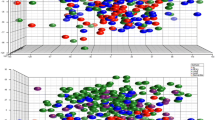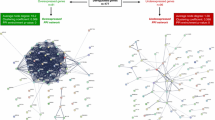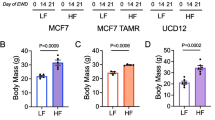Abstract
Obesity is thought to contribute to worse disease outcome in breast cancer as a result of increased levels of adipocyte-secreted endocrine factors, insulin, and insulin-like growth factors (IGFs) that accelerate tumor cell proliferation and impair treatment response. We examined the effects of patient obesity on primary breast tumor gene expression, by profiling transcription of a set of 103 tumors for which the patients’ body mass index (BMI) was ascertained. Sample profiles were stratified according to patients’ obesity phenotype defined as normal (BMI < 25), overweight (BMI 25–29.9), or obese (BMI ≥ 30). Widespread gene expression alterations were evident in breast tumors from obese patients as compared to other tumors, allowing us to define an obesity-associated cancer transcriptional signature of 662 genes. In multiple public expression data sets of breast cancers (representing > 1,500 patients), manifestation of the obesity signature patterns correlated with manifestation of a gene signature for IGF signaling and (to a lesser extent) with lower levels of estrogen receptor. In one patient cohort, manifestation of the obesity signature correlated with shorter time to metastases. A number of small molecules either induced or suppressed the obesity-associated transcriptional program in vitro; estrogens alpha-estradiol, levonorgestrel, and hexestrol induced the program, while several anti-parkinsonian agents targeting neurotransmitter receptor pathways repressed the program. Obesity in breast cancer patients appears to impact the gene expression patterns of the tumor (perhaps as a result of altered body chemistry). These results warrant further investigation of obesity-associated modifiers of breast cancer risk and disease outcome.



Similar content being viewed by others
Abbreviations
- BMI:
-
Body mass index
- ER:
-
Estrogen receptor (alpha)
- IGF:
-
Insulin-like growth factor
- CMap:
-
Connectivity map
References
WHO Expert Committee (1995) Physical status: the use and interpretation of anthropometry (WHO technical report series no. 854). World Health Organization, Geneva
de Onis M, Habicht J (1996) Anthropometric reference data for international use: recommendations from a World Health Organization Expert Committee. Am J Clin Nutr 64:650–658
Bernstein L, Ross R (1993) Endogenous hormones and breast cancer risk. Epidemiol Rev 15:48–65
Jones B, Kasi S, Curnen M, Owens P, Dubrow R (1997) Severe obesity as an explanatory factor for the black/white difference in stage at diagnosis of breast cancer. Am J Epidemiol 146(5):394–404
Dirat B, Bochet L, Escourrou G, Valet P, Muller C (2010) Unraveling the obesity and breast cancer links: a role for cancer-associated adipocytes? Endocr Dev 19:45–52
Dawood S, Broglio K, Gonzalez-Angulo A, Kau S, Islam R, Hortobagyi G, Cristofanilli M (2008) Prognostic value of body mass index in locally advanced breast cancer. Clin Cancer Res 14(6):1718–1725
McTiernan A, Irwin M, Vongruenigen V (2010) Weight, physical activity, diet, and prognosis in breast and gynecologic cancers. J Clin Oncol 28(26):4074–4080
Perou CM, Sorlie T, Eisen MB, van de Rijn M, Jeffrey SS, Rees CA, Pollack JR, Ross DT, Johnsen H, Akslen LA, Fluge O, Pergamenschikov A, Williams C, Zhu SX, Lonning PE, Borresen-Dale AL, Brown PO, Botstein D (2000) Molecular portraits of human breast tumours. Nature 406(6797):747–752
van de Vijver MJ, He YD, Van’t Veer LJ, Dai H, Hart AA, Voskuil DW, Schreiber GJ, Peterse JL, Roberts C, Marton MJ (2002) A gene-expression signature as a predictor of survival in breast cancer. N Engl J Med 347:1999–2009
Wang Y, Klijn JG, Zhang Y, Sieuwerts AM, Look MP, Yang F, Talantov D, Timmermans M, Meijer-van Gelder ME, Yu J (2005) Gene-expression profiles to predict distant metastasis of lymph-node-negative primary breast cancer. Lancet 365:671–679
Loi S, Haibe-Kains B, Desmedt C, Lallemand F, Tutt AM, Gillet C, Ellis P, Harris A, Bergh J, Foekens JA, Klijn JGM, Larsimont D, Buyse M, Bontempi G, Delorenzi M, Piccart MJ, Sotiriou C (2007) Definition of clinically distinct molecular subtypes in estrogen receptor-positive breast carcinomas through genomic grade. J Clin Oncol 25(10):1239–1246
Desmedt C, Piette F, Loi S, Wang Y, Lallemand F, Haibe-Kains B, Viale G, Delorenzi M, Zhang Y, d’Assignies M, Bergh J, Lidereau R, Ellis P, Harris A, Klijn J, Foekens J, Cardoso F, Piccart M, Buyse M, Sotiriou C (2007) TRANSBIG_Consortium, strong time dependence of the 76-gene prognostic signature for node-negative breast cancer patients in the TRANSBIG multicenter independent validation series. Clin Cancer Res 13(11):3207–3214
Hoadley K, Weigman V, Fan C, Sawyer L, He X, Troester M, Sartor C, Rieger-House T, Bernard P, Carey L, Perou C (2007) EGFR associated expression profiles vary with breast tumor subtype. BMC Genomics 8(1):258
Miller LD, Smeds J, George J, Vega VB, Vergara L, Ploner A, Pawitan Y, Hall P, Klaar S, Liu ET, Bergh J (2005) An expression signature for p53 status in human breast cancer predicts mutation status, transcriptional effects, and patient survival. Proc Natl Acad Sci USA 102(38):13550–13555. doi:10.1073/pnas.0506230102
Chang JC, Wooten EC, Tsimelzon A, Hilsenbeck SG, Gutierrez MC, Elledge R, Mohsin S, Osborne CK, Chamness GC, Allred DC, O’Connell P (2003) Gene expression profiling for the prediction of therapeutic response to docetaxel in patients with breast cancer. Lancet 362(9381):362–369
Storey JD, Tibshirani R (2003) Statistical significance for genomewide studies. Proc Natl Acad Sci USA 100:9440–9445
Saldanha AJ (2004) Java treeview—extensible visualization of microarray data. Bioinformatics 20:3246–3248
Eisen MB, Spellman PT, Brown PO, Botstein D (1998) Cluster analysis and display of genome-wide expression patterns. Proc Natl Acad Sci USA 95:14863–14868
Creighton C, Nagaraja A, Hanash S, Matzuk M, Gunaratne P (2008) A bioinformatics tool for linking gene expression profiling results with public databases of microRNA target predictions. RNA 14(11):2290–2296
Creighton C, Casa A, Lazard Z, Huang S, Tsimelzon A, Hilsenbeck S, Osborne C, Lee A (2008) Insulin-like growth factor I (IGF-I) activates gene transcription programs strongly associated with poor breast cancer prognosis. J Clin Oncol 26(25):4078–4085
Calle E, Kaaks R (2004) Overweight, obesity and cancer: epidemiological evidence and proposed mechanisms. Nat Rev Cancer 4:579–591
Creighton C, Fu X, Hennessy B, Casa A, Zhang Y, Gonzalez-Angulo A, Lluch A, Gray J, Brown P, Hilsenbeck S, Osborne C, Mills G, Lee A, Schiff R (2010) Proteomic and transcriptomic profiling reveals a link between the PI3K pathway and lower estrogen-receptor (ER) levels and activity in ER+breast cancer. Breast Cancer Res 12(3):R40
Creighton CJ, Hilger AM, Murthy S, Rae JM, Chinnaiyan AM, El-Ashry D (2006) Activation of mitogen-activated protein kinase in estrogen receptor {alpha}-positive breast cancer cells in vitro induces an in vivo molecular phenotype of estrogen receptor {alpha}-negative human breast tumors. Cancer Res 66(7):3903–3911
Creighton CJ, Cordero KE, Larios JM, Miller RS, Johnson MD, Chinnaiyan AM, Lippman ME, Rae JM (2006) Genes regulated by estrogen in breast tumor cells in vitro are similarly regulated in vivo in tumor xenografts and human breast tumors. Genome Biol 7(4):R28
Lamb J, Crawford ED, Peck D, Modell JW, Blat IC, Wrobel MJ, Lerner J, Brunet J-P, Subramanian A, Ross KN, Reich M, Hieronymus H, Wei G, Armstrong SA, Haggarty SJ, Clemons PA, Wei R, Carr SA, Lander ES, Golub TR (2006) The connectivity map: using gene-expression signatures to connect small molecules, genes, and disease. Science 313(5795):1929–1935. doi:10.1126/science.1132939
Pinheiro R, Sarian L, Pinto-Neto A, Morais S, Costa-Paiva L (2009) Relationship between body mass index, waist circumference and waist to hip ratio and the steroid hormone receptor status in breast carcinoma of pre- and postmenopausal women. Breast Cancer Res 18(1):8–12
Renehan A, Frystyk J, Flyvbjerg A (2006) Obesity and cancer risk: the role of the insulin-IGF axis. Trends Endocrinol Metab 17(8):328–336
Wang G, Volkow N, Fowler J (2002) The role of dopamine in motivation for food in humans: implications for obesity. Expert Opin Ther Targets 6(5):601–609
Maresca A, Supuran C (2008) Muscarinic acetylcholine receptors as therapeutic targets for obesity. Expert Opin Ther Targets 12(9):1167–1175
Acknowledgments
The authors deeply thank Drs. Peter O’Connell and Diane Wilson for their preliminary guidance in the formulation of this research study. This study was supported in part by the National Institutes of Health Grant P30CA125123, the National Cancer Institute Breast Cancer SPORE Grant P50 CA50183, National Cancer Institute Grant 5R01CA138197-02, and the US Army Medical Research and Material Command DAMD17-01-0132 and W81XWH-04-1-0468.
Conflicts of interest
None.
Author information
Authors and Affiliations
Corresponding author
Additional information
Chad J. Creighton and Yvonne H. Sada contributed equally to this study
Electronic supplementary material
Below is the link to the electronic supplementary material.
Rights and permissions
About this article
Cite this article
Creighton, C.J., Sada, Y.H., Zhang, Y. et al. A gene transcription signature of obesity in breast cancer. Breast Cancer Res Treat 132, 993–1000 (2012). https://doi.org/10.1007/s10549-011-1595-y
Received:
Accepted:
Published:
Issue Date:
DOI: https://doi.org/10.1007/s10549-011-1595-y




